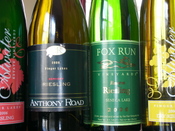By Lenn Thompson, Founder and Publisher
If the Napa Valley is cabernet sauvignon country and Long Island is the land of merlot (and cabernet franc), the Finger Lakes region is definitely the U.S. region where riesling shines brightest. The deep, narrow lakes that give the region its name gather and hold a significant amount of heat in the warm summer season, extending the grape-growing season just long enough to ripen grapes as well as protect vineyards against potentially catastrophic early frosts.
Recently, James Molesworth, on WineSpectator.com rated several Finger Lakes Rieslings well — in the high 80s — with Anthony Road Winery’s 2006 Semi-Dry Riesling receiving the highest rasting, an 89. Several wines were awarded 88-point scores, including Atwater Estate Vineyards 2006 Riesling, Chateau Lafayette Reneau 2006 Johannisberg Riesling, Fox Run Vineyard’s 2006 Riesling Reserve, Red Newt Cellars 2006 Reserve Riesling, Anthony Road Winery’s 2006 Dry Riesling and Atwater Estate Vineyards 2006 Dry Riesling. Several wines also received scores between 85 and 87. I’ve tasted most of these wines, and they certainly deserve high scores in my book.
It’s interesting to me, however, that with so many wines so close to that magical 90-point score that none of them pushed through that barrier. Interesting probably isn’t a strong enough word for how I feel about it. Suspect and ridiculous seem more appropriate.
I’m not sure if Mr. Molesworth did these scores himself or how he conducted the tasting, but I know how Wine Spectator has conducted "blind" tasting session in the past. You see, blind belongs in quotes because they aren’t truly blind. Members of the tasting panel don’t know the individual producers before them, but they do know the vintage and grape(s) they’re tasting as well the region the wines come from. Is it possible that a preconceived notion about a region come into play? I think it’s more than possible. It’s likely.
The last time Wine Spectator did an extensive piece on Long Island wines, there weren’t any wines scoring 90 or above either.
I can’t help but wonder what would happen if you put some of that 89-point Anthony Road riesling into a bottle featuring a German label. Or, if you put one of Long Island’s best merlots in a Bordeaux-labeled bottle. Maybe the scores wouldn’t be any different, but I’m not convinced that many (if any) people can tell the difference between an 89 and a 90 anyway.
It really makes me wonder why Spectator does their tastings this way. Why not do truly blind tastings? Is it just we’ve-always-done-it-this-way stubbornness, or is it to protect their tasters from giving a high score to a wine from an ‘unworthy’ region?
Editors note: Jason Feulner, LENNDEVOURS’ Finger Lakes Correspondent wrote about this topic as well. Instead of publishing both, I’ve asked him to either comment on this post, or write a follow-up post later this week.

